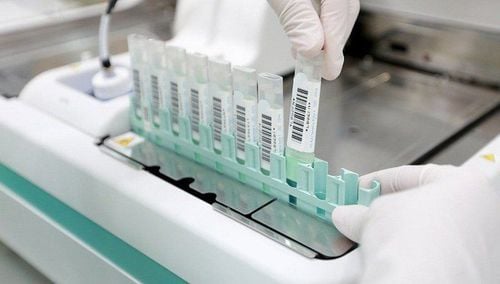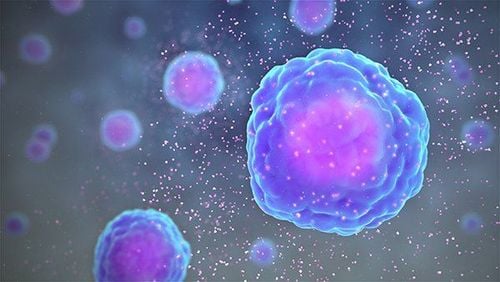This is an automatically translated article.
The article was written by Specialist Doctor I Nguyen Thi Minh Thuyen - Pathologist, Pathology Department - Vinmec Danang International General Hospital.Multiple myeloma usually affects areas where the bone marrow is still active in adults, such as the skull, spine, ribs, pelvis, and shoulder blades. The rest of the body, such as the bones of the hands, feet, forearms, and legs, are less often affected.
1. What is multiple myeloma?
Cancer begins when cells grow out of control. Cells in almost any part of the body can become cancerous, and can spread to other organs. Multiple myeloma is a cancer of the plasma cells (plasma cells). Normal plasma cells are found in the bone marrow and are an important part of the immune system.
The immune system is made up of several types of cells that work together to fight infections and other diseases. Lymphocytes (lymphocytes) are one of the main types of white blood cells in the immune system, including T cells and B cells. Lymphocytes are found in many parts of the body, such as the lymph nodes. lymph, bone marrow, intestines and blood.
When B cells respond to infection, they mature and change into plasma cells. Plasma cells produce antibodies (also called immunoglobulins) that help the body attack and destroy pathogens. Plasma cells, which are found mainly in the bone marrow (bone marrow is the soft tissue inside the bones). In addition to plasma cells, normal bone marrow is also the home for other blood cells such as red blood cells, white blood cells, and platelets.
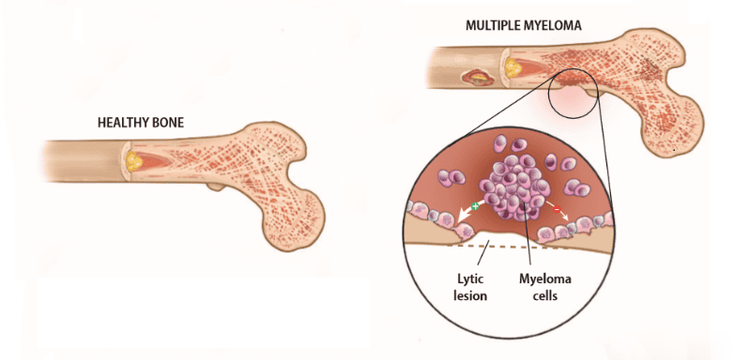
Generally, when plasma cells become cancerous and grow out of control, it is called multiple myeloma. The plasma cells produce an abnormal protein (antibody) that is known by various names, such as monoclonal immunoglobulin, monoclonal protein (M-protein), M-spike, or paraprotein.
However, there are other disorders that also have abnormal plasma cells but do not meet the criteria to be called active multiple myeloma. Other plasmacytic disorders include: Monoclonal gammopathy of uncertain significance (MGUS) Smoldering multiple myeloma (SMM) Solitary plasmacytoma light chain amyloidosis
2. Features of multiple myeloma
2.1 Low blood count In multiple myeloma, an overgrowth of plasma cells in the bone marrow can crowd out normal hematopoietic cells, resulting in low blood counts.This can cause anemia (lack of red blood cells), the body becomes weak and tired. Multiple myeloma can also cause low platelets in the blood (thrombocytopenia), which can lead to an increased risk of bleeding and bruising. Another possible condition is leukopenia (lack of normal white blood cells), and can lead to problems fighting infection. 2.2 Bone and calcium problems Bones are constantly being regenerated to keep them strong. Two types of bone cells work together to keep bones strong and healthy:
Osteoclasts break down old bone Osteoblasts make new bone Cells in myeloma also interfere with this cell. Tumor cells produce a substance that causes osteoclasts to speed up bone destruction. So much old bone is destroyed without new bone to replace it, making the bone weak and brittle. Fractures are a big problem in people with myeloma. This increase in bone breakdown can also increase blood calcium levels.
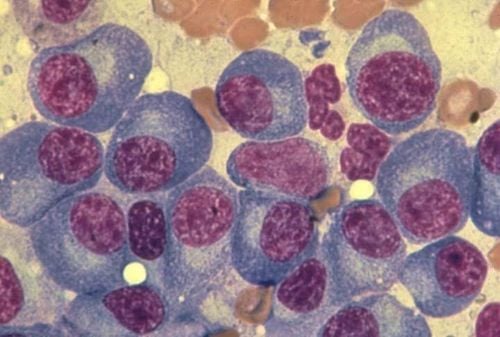
2.4 Kidney problems Tumor cells produce an antibody that can damage the kidneys, leading to kidney damage and even kidney failure.
3. Causes, risk factors and ways to prevent
Learn about multiple myeloma risk factors and what can help reduce your risk.
3.1 Risk Factors A risk factor is anything that affects the likelihood of getting a disease like cancer. Different cancers have different risks. For example, exposing the skin to strong sunlight is a risk factor for skin cancer.
Smoking is a risk factor for lung cancer and many other cancers. But risk factors don't tell us everything. People with no risk factors can still get the disease. Conversely, having one risk factor, or even several, does not mean you will develop the disease.
Here are a few risk factors that can affect your chances of getting multiple myeloma.
Age: the risk of multiple myeloma increases with age. Less than 1% of cases are diagnosed in people under the age of 35. Most people diagnosed with this cancer are at least 65 years old. Gender: Men are more likely to have multiple myeloma than women. Family history: People with a sibling or parent with myeloma are more likely to have the disease than someone without this family history. However, most patients do not have a close relative with the disease, so family history accounts for only a small number of cases. Obesity: Being overweight or obese increases the risk of multiple myeloma. Other plasma cell disease: individuals with monoclonal disease of undetermined significance (MGUS) or plasmacytoma alone have a higher risk of developing multiple myeloma than individuals without these conditions.

3.2 What causes multiple myeloma? Scientists still don't know exactly what causes most cases of multiple myeloma. However, they have made progress to understand how certain changes in DNA can cause plasma cells to become cancerous.
Some genes (parts of DNA) control when their cells grow and divide. Genes that promote cell growth are called oncogenes. Other genes that slow down cell growth or cause cells to die at the right time are called tumor suppressor genes. Cancer can be caused by mistakes, or defects, in DNA called mutations in oncogenes or tumor suppressor genes.
Recent studies have found that abnormalities of some oncogenes (such as MYC) develop early in plasma cell tumors. Changes in other oncogenes (such as the RAS gene) are commonly found in myeloid cells in the bone marrow after treatment, and changes in tumor suppressor genes (such as the p53 gene) have been implicated in the spread of cancer. other agencies.
Cells in myeloma also show abnormalities in their chromosomes. In human cells, DNA is combined to form chromosomes. Although normal human cells contain 46 chromosomes, some cancer cells may have extra chromosomes (called chromosomal duplications) or be missing all or part of them (called chromosomal duplications). chromosomal deletion). A common finding in myeloma cells is that portions of chromosome 17 are missing. This deletion makes the myeloma more advanced and resistant to treatment.
About half of people with myeloma, part of one chromosome has moved to another in the tumor cell, it's called a chromosomal translocation. When a translocation occurs in the region adjacent to an oncogene, it can cause an oncogene mutation.
Researchers have found that patients with plasma cell tumors have important abnormalities in other bone marrow cells, and these abnormalities can also cause excessive plasma cell growth. Some cells in the bone marrow (called dendritic cells) release a hormone called interleukin-6 (IL-6), which stimulates normal plasma cells to grow. Overproduction of IL-6 by these cells appears to be an important factor in the development of plasma cell tumors.
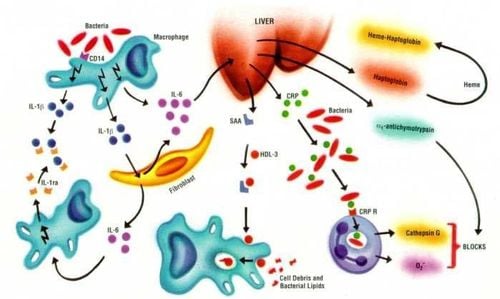
3.3 Prevention For some types of cancer, risk factors are known in the majority of cases. For example, smoking causes most lung cancers, so there is a chance for prevention.
With multiple myeloma, some cases are associated with avoidable risk factors, while in others there is almost no way to prevent them from developing.
Vinmec International General Hospital is one of the hospitals that not only ensures professional quality with a team of leading medical doctors, modern equipment and technology, but also stands out for its examination and consultation services. comprehensive and professional medical consultation and treatment; civilized, polite, safe and sterile medical examination and treatment space.
Please dial HOTLINE for more information or register for an appointment HERE. Download MyVinmec app to make appointments faster and to manage your bookings easily.
Article referenced source: American Cancer Society






